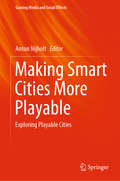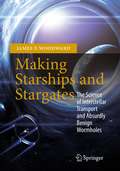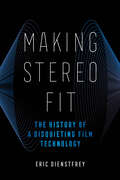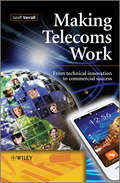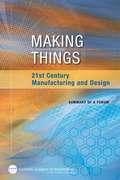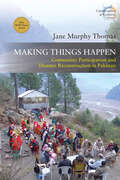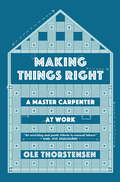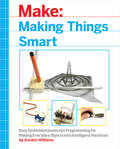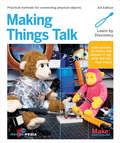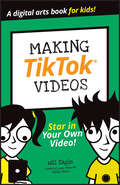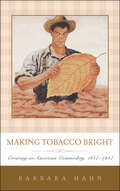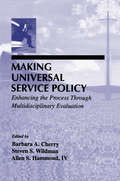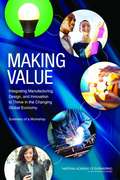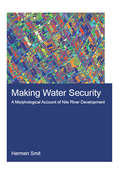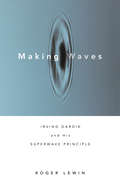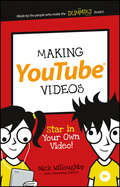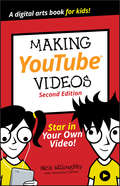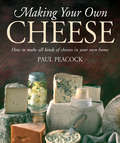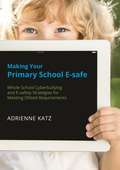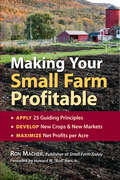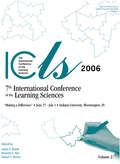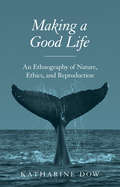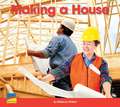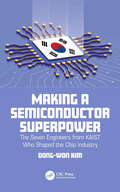- Table View
- List View
Making Smart Cities More Playable: Exploring Playable Cities (Gaming Media and Social Effects)
by Anton NijholtThis book explores the ways in which the broad range of technologies that make up the smart city infrastructure can be harnessed to incorporate more playfulness into the day-to-day activities that take place within smart cities, making them not only more efficient but also more enjoyable for the people who live and work within their confines. The book addresses various topics that will be of interest to playable cities stakeholders, including the human–computer interaction and game designer communities, computer scientists researching sensor and actuator technology in public spaces, urban designers, and (hopefully) urban policymakers. This is a follow-up to another book on Playable Cities edited by Anton Nijholt and published in 2017 in the same book series, Gaming Media and Social Effects.
Making Starships and Stargates
by James F. WoodwardTo create the exotic materials and technologies needed to make stargates and warp drives is the holy grail of advanced propulsion. A less ambitious, but nonetheless revolutionary, goal is finding a way to accelerate a spaceship without having to lug along a gargantuan reservoir of fuel that you blow out a tailpipe. Tethers and solar sails are conventional realizations of the basic idea. There may now be a way to achieve these lofty objectives. "Making Starships and Stargates" will have three parts. The first will deal with information about the theories of relativity needed to understand the predictions of the effects that make possible the "propulsion" techniques, and an explanation of those techniques. The second will deal with experimental investigations into the feasibility of the predicted effects; that is, do the effects exist and can they be applied to propulsion? The third part of the book - the most speculative - will examine the question: what physics is needed if we are to make wormholes and warp drives? Is such physics plausible? And how might we go about actually building such devices? This book pulls all of that material together from various sources, updates and revises it, and presents it in a coherent form so that those interested will be able to find everything of relevance all in one place.
Making Stereo Fit: The History of a Disquieting Film Technology (California Studies in Music, Sound, and Media #6)
by Eric DienstfreySurround sound is often mistaken as a relatively new phenomenon in cinemas, one that emerged in the 1970s with the arrival of Dolby. Making Stereo Fit reveals that, in fact, filmmakers have been creating stereo and surround-sound effects for nearly a century, since the advent of talking pictures, and argues that their endurance owes primarily to the longstanding battles between stereo and mono technologies. Throughout the book, Eric Dienstfrey analyzes newly discovered archival materials and myriad stereo releases, from Hell’s Angels (1930) to Get Out (2017), to show how Hollywood’s financial dependence on mono prevented filmmakers from seeing surround sound’s full aesthetic potential. Though studios initially explored stereo’s unique capabilities, Dienstfrey details how filmmakers eventually codified a conservative set of surround-sound techniques that prevail today, despite the arrival of more immersive formats.
Making Telecoms Work
by Geoff VarrallBridging the industry divide between the technical expertise of engineers and the aims of market and business planners, Making Telecoms Work provides a basis for more effective interdisciplinary analysis of technology, engineering, market and business investment risk and opportunity. Since fixed and mobile broadband has become a dominant deliverable, multiple areas of transition and transformation have occurred; the book places these changes in the context of the political, social and economic dynamics of the global telecommunications industry.Drawing on 25 years of participative experience in the mobile phone and telecommunications industry, the author closely analyses the materials, components and devices that have had a transformative impact. By presenting detailed case studies of materials innovation, such as those shown at success story Apple, the book shows how the collaboration of technological imagination with business knowledge will shape the industry's future.Makes a link between the technical aspects and the business practice of the telecoms industry, highlighting the commercial and economic significance of new developmentsGives a historical analysis of past successes and failures in order to identify future competitive advantage opportunitiesSupplies detailed case studies of supply chain disconnects and the impact these have on industry risk and profitabilityBrings together technological detail with analysis of what is and is not commercially important, from the implications of energy and environmental networks to the technical details of wireless network hardware.
Making Things
by Steve Olson National Academy of Engineering National AcademiesMore than two decades ago, a commission of 17 MIT scientists and economists released a report, Made in America, which opened with the memorable phrase, "To live well, a nation must produce well." Is that still true? Or can the United States remain a preeminent nation while other countries increasingly make the products that once were made in America? These questions were at the center of a forum titled "Making Things: 21st Century Manufacturing and Design" held during the 2011 Annual Meeting of the National Academy of Engineering. In a wide-ranging and provocative conversation, seven leaders of business, government, and academia explored the many facets of manufacturing and design and outlined the many opportunities and responsibilities posed by manufacturing for the engineering profession. Making Things: 21st Century Manufacturing and Design summarizes the discussions that took place during the 2011 forum. The report concludes with a forum agenda and each attendee's bibliography.
Making Things Happen: Community Participation and Disaster Reconstruction in Pakistan (Catastrophes in Context #5)
by Jane Murphy ThomasDrawing on the Pakistan Earthquake Reconstruction and Recovery Project (PERRP), this volume explores the sociocultural side of post-disaster infrastructure reconstruction. As the latter is often fraught with delays and even abandonment—one cause being ineffective interactions between construction and local people—PERRP used anthropological and participatory approaches. Along with strong construction management, such approaches led to the rebuilding being completed on time. As disasters are increasing in number and intensity, so too will be the need for reconstruction, for which PERRP has lessons to offer.
Making Things Right: A Master Carpenter at Work
by Ole ThorstensenA celebration of good craftsmanship by a Norwegian master carpenter - the anatomy of a job well done."An enriching and poetic tribute to manual labour" Karl Ove Knausgård"In Thorstensen's skilled hands, the everyday story of a suburban loft conversion is turned into an urgent study on the value of doing good work. It should be widely read." Robert Penn - author of The Man Who Made Things Out of TreesThis is, quite simply, the story of a loft conversion. It is also a book about work and identity, about collaboration and pride in skilled craftsmanship, and about what it means to make things with your hands in a consumerism-driven world. A master carpenter and builder with thirty years' experience, Thorstensen gives a matter-of-fact, reflective voice to the workers who construct our living spaces and our urban environment. He looks upon his tools as an important part of himself and as a reflection of his respect for his trade, and he addresses the gulf in understanding and communication between skilled craftsmen and "academic" workers. From the moment of a client's phone call to their occupation of a newly constructed living space, Making Things Right tracks the project as it takes shape: the delicate negotiation to establish an optimum plan; the collaboration with a trusted team of specialist painters, plasterers, plumbers, electricians; the handling of materials; the blood, sweat and frustration involved in doing a job well. Why is it that manual skills are underestimated? After all, working with your hands gives you time to think. With all its practical detail, Making Things Right is the simple philosophy of a working life.Will interest readers of The Craftsman by Richard Sennett: Kitchen Confidential by Anthony Bourdain; The Man Who Made Things Out of Trees by Robert Penn; Do No Harm by James Marsh and A Shepherd's Life by James RebanksTranslated from the Norwegian by Sean Kinsella
Making Things Smart: Easy Embedded JavaScript Programming for Making Everyday Objects into Intelligent Machines
by Gordon F. WilliamsMaking Things Smart teaches the fundamentals of the powerful ARM microcontroller by walking beginners and experienced users alike through easily assembled projects comprised of inexpensive, hardware-store parts.Current ARM programming books take a bland, textbook approach focused on complex, beginner-unfriendly languages like C or ARM Assembler. Making Things Smart uses Espruino (JavaScript for Hardware), flattening the learning curve.
Making Things Talk: Using Sensors, Networks, and Arduino to See, Hear, and Feel Your World
by Tom IgoeThe workbenches of hobbyists, hackers, and makers have become overrun with microcontrollers, computers-on-a-chip that power homebrewed video games, robots, toys, and more. In Making Things Talk, Tom Igoe, one of the creators of Arduino, shows how to make these gadgets talk. Whether you need to connect some sensors to the Internet or create a device that can interact wirelessly with other creations, this book shows you what you need. Although they are powerful, the projects in this book are inexpensive to build: the Arduino microcontroller board itself ranges from around $25 to $40. The networking hardware covered here includes Ethernet, Wi-Fi, Bluetooth, and can be had for $25 to $50. Fully updated for the latest Arduino hardware and software, this book lets you combine microcontrollers, sensors, and networking hardware to make things... and make them talk to each other!
Making TikTok Videos (Dummies Junior)
by Andrew Cooper Claire Cohen Will Eagle Hannah Budke Jordan Elijah Michael Andrew PanturescuCreate videos using the tricks of TikTok stars! Making TikTok Videos reveals the secrets that TikTok celebs and influencers use to make the videos that everyone’s watching. Hilarious clips, the latest dances, instruction videos—whatever you want to do, make sure it shows off the latest TikTok styles. This book shows you how to use whatever you have on hand to record, edit, and upload TikToks. Add music and text, get creative, and start sharing your finished products. With this guide, you’ll get easy instructions on how to make videos that people remember. You also get some tips on how to bring viewers to your account. Use your mobile device to shoot videos with top-notch sound Learn the editing tricks TikTok pros use to create a finished video Set up your TikTok account and set your privacy Keep up with the latest TikTok video stylesWritten especially for the 10-14 age group interested in creating their first TikTok videos, this Dummies Jr. title will help you get plugged into the TikTok universe.
Making Tobacco Bright: Creating an American Commodity, 1617–1937 (Johns Hopkins Studies in the History of Technology)
by Barbara M. HahnHow did Bright Flue-Cured Tobacco come to dominate the industry?In her sweeping history of the American tobacco industry, Barbara Hahn traces the emergence of the tobacco plant’s many varietal types, arguing that they are products not of nature but of economic relations and continued and intense market regulation. Hahn focuses her study on the most popular of these varieties, Bright Flue-Cured Tobacco. First grown in the inland Piedmont along the Virginia–North Carolina border, Bright Tobacco now grows all over the world, primarily because of its unique—and easily replicated—cultivation and curing methods. Hahn traces the evolution of technologies in a variety of regulatory and cultural environments to reconstruct how Bright Tobacco became, and remains to this day, a leading commodity in the global tobacco industry. This study asks not what effect tobacco had on the world market, but how that market shaped tobacco into types that served specific purposes and became distinguishable from one another more by technologies of production than genetics. In so doing, it explores the intersection of crossbreeding, tobacco-raising technology, changing popular demand, attempts at regulation, and sheer marketing ingenuity during the heyday of the American tobacco industry. Combining economic theory with the history of technology, Making Tobacco Bright revises several narratives in American history, from colonial staple-crop agriculture to the origins of the tobacco industry to the rise of identity politics in the twentieth century.
Making Universal Service Policy: Enhancing the Process Through Multidisciplinary Evaluation (LEA Telecommunications Series)
by Iv Barbara A. Cherry Steven S. Wildman Allen S. HammondThis book is the outgrowth of shared interests between the editors and the contributing authors to provide a multidisciplinary perspective in evaluating universal service policy and recommending policy changes to accommodate a more competitive telecommunications environment. The book is interdisciplinary in nature to reflect the extremely complex context in which universal service policy is formed. The chapter authors represent a broad cross-section of disciplinary training, professional positions, and relationships in the telecommunications industry. Academic disciplines represented include law, economics, anthropology, communication, and business. This book's purpose is to significantly enhance the development of effective telecommunications universal service policy among policymakers, industry members, and stakeholders in the United States. Universal service policy has been, and will continue to be, both enabled and constrained by the simultaneous interaction of social, political, technological, and economic forces in the environment in which it is formed. A more effective process for policy design is to seek agreement on how entitlements embedded in universal service policy should be modified as circumstances invariably change over time. Therefore, the volume reflects recent significant developments in U.S. universal service policy--the implementation of which continues to unfold.
Making Value
by Steve Olson National Academy of Engineering Kate S. WhitefootManufacturing is in a period of dramatic transformation. But in the United States, public and political dialogue is simplistically focused almost entirely on the movement of certain manufacturing jobs overseas to low-wage countries. The true picture is much more complicated, and also more positive, than this dialogue implies. After years of despair, many observers of US manufacturing are now more optimistic. A recent uptick in manufacturing employment and output in the United States is one factor they cite, but the main reasons for optimism are much more fundamental. Manufacturing is changing in ways that may favor American ingenuity. Rapidly advancing technologies in areas such as biomanufacturing, robotics, smart sensors, cloud-based computing, and nanotechnology have transformed not only the factory floor but also the way products are invented and designed, putting a premium on continual innovation and highly skilled workers. A shift in manufacturing toward smaller runs and custom-designed products is favoring agile and adaptable workplaces, business models, and employees, all of which have become a specialty in the United States. Future manufacturing will involve a global supply web, but the United States has a potentially great advantage because of our tight connections among innovations, design, and manufacturing and also our ability to integrate products and services. The National Academy of Engineering has been concerned about the issues surrounding manufacturing and is excited by the prospect of dramatic change. On June 11-12, 2012, it hosted a workshop in Washington, DC, to discuss the new world of manufacturing and how to position the United States to thrive in this world. The workshop steering committee focused on two particular goals. First, presenters and participants were to examine not just manufacturing but the broad array of activities that are inherently associated with manufacturing, including innovation and design. Second, the committee wanted to focus not just on making things but on making value, since value is the quality that will underlie high-paying jobs in America's future. Making Value: Integrating Manufacturing, Design, and Innovation to Thrive in the Changing Global Economy summarizes the workshop and the topics discussed by participants.
Making Value for America: Embracing the Future of Manufacturing, Technology, and Work
by Nicholas M. DonofrioGlobalization, developments in technology, and new business models are transforming the way products and services are conceived, designed, made, and distributed in the U. S. and around the world. These forces present challenges - lower wages and fewer jobs for a growing fraction of middle-class workers - as well as opportunities for "makers" and aspiring entrepreneurs to create entirely new types of businesses and jobs. Making Value for America examines these challenges and opportunities and offers recommendations for collaborative actions between government, industry, and education institutions to help ensure that the U. S. thrives amid global economic changes and remains a leading environment for innovation. Filled with real-life examples, Making Value for America presents a roadmap to enhance the nation's capacity to pursue opportunities and adapt to transforming value chains by widespread adoption of best practices, a well-prepared and innovative workforce, local innovation networks to support startups and new products, improved flow of capital investments, and infrastructure upgrades.
Making Water Security: A Morphological Account of Nile River Development (IHE Delft PhD Thesis Series)
by Hermen SmitThis book examines Nile water security through the morphology of the river: it uses the always changing form of the river as a theoretical and empirical device to map and understand how infrastructures and discourses dynamically interact with the Nile. By bringing a history of two centuries of dam development on the Nile in relation with the drainage of a hill slope in Ethiopia on the one hand and irrigation reform in Sudan on the other, the author shows how the scales, units and ‘populations’ figuring in projects to securitize the river emerge through the rearrangement of its water and sediments. The analysis of ‘Making water security’ is more than yet another story of how modern projects of water security have legitimized often violent dispossessions of Nile land and water. It shows how no water user is confined by the roles assigned by project engineers and planners. As ongoing modern ‘development’ of the river reduces the prospects for new large diversions of water, the targeted subjects of development and modernization make use of newly opened spaces to carve out their own projects. They creatively mobilize old irrigation and drainage infrastructures in ways that escape the universal logic of water security.
Making Waves: Irving Dardik and His Superwave Principle
by Roger LewinThe biography of a medical maverick who is challenging scientific convention with his astounding approach to achieving and maintaining health.Dr. Irving Dardik's radical notions about how all matter moves in interconnected waves has drawn deep skepticism from physicists, and his early attempts to put his theory into practice in the field of health care got him banned from practicing medicine in the 1990s. But now, after a decade's worth of rigorous research that seems to support Dardik's SuperWave theory, scientists at such esteemed institutions as MIT, Harvard, and Stanford Research International are signing on with Dardik's team to probe the possibilities. For example, Dardik's unique approach to physical exercise, based on his Principle, has achieved some remarkable successes in reversing symptoms of chronic disease.Making Waves weaves together two fascinating stories: Dardik's personal progression from vascular surgeon to scientific iconoclast and pioneer, chronicling his struggle to convince the scientific community to take him seriously; and the evolution of his mind-expanding SuperWave Principle. Colleagues--skeptics as well as supporters--consider the impact of SuperWave theory on current thinking about nature on all scales, from the universe to the subatomic world, and in the realms of biology, applied science, and medicine. The resulting read will interest those concerned with their own health and vitality as well as those curious about the fundamental workings of nature.
Making YouTube Videos
by Nick WilloughbyThe fast and easy way for kids to shoot, edit, and share videos on YouTube Does your child long to create and post videos on YouTube in hopes of becoming the next "YouTube celebrity?" Whether looking to go viral or simply wanting to make videos for their friends, Making YouTube Videos is the place your kid should start. Written by a filmmaking expert who runs camps for wanna-be filmmakers as young as seven, this fun and friendly guide takes your child step by step through the process: from idea creation to production to sharing on YouTube. Written in a language they'll understand and filled with eye-popping graphics that make the information come to life, Making YouTube Videos takes the intimidation out of working with video technology and offers your child a friendly, trusted source for expressing their creativity. Kids will work through small projects with end-goals that help promote confidence. With content that is accessible and easy to understand, this book is ideal for youngsters who want to go solo or work with you or another adult instructor. Introduces ideas on framing, lighting, and sound Shows kids how to load a video, add transitions, and add effects Provides easy-to-follow instruction on uploading a video to YouTube and setting who can see or not see their video Explains how to grab free software and make simple edits, like cutting out scenes, adding to a timeline, and implementing transitions If you want to encourage your child's enthusiasm but don't want to endure a meltdown, Making YouTube Videos makes it easy for your aspiring filmmaker to fulfill his or her dream.
Making YouTube Videos: Star In Your Own Video! (Dummies Junior)
by Nick WilloughbyEverything kids need to create and star in their own video! YouTube has won the hearts, minds, and eyes of kids around the globe. Young people everywhere are making their mark on this popular platform—some of them even gaining massive followings, worldwide recognition, and the paychecks that come along with it. While lots of youngsters are happy to be spectators, others are hungry to create and star in YouTube content of their own—and this book shows them how. Written for kids in a language they can understand, this book helps budding filmmakers and producers create their own videos—no matter the subject. It offers creators the insight on how to plan and shoot quality videos, install and use video editing tools, and post the final product to YouTube. Apply tricks that pro filmmakers use for better shots, lighting, and sound Edit your video, add transitions, insert a soundtrack, and spice things up with effects Shoot and share your video gaming exploits Share finished videos with family, friends, and the world For any kid interested in joining the YouTube revolution, this book is the perfect place to start!
Making Your Own Cheese: How to Make All Kinds of Cheeses in Your Own Home
by Paul PeacockNot everyone can keep a cow, but everyone can make cheese. This book shows you the very basic equipment needed to make your own cheese: the ingredients, including different milks, herbs and flavours; how to make a simple cheese; and how to produce some of the worlds speciality cheeses such as Roquefort, Brie and Edam. You will find recipes for making many cheeses at home. Whether you are making a cheese cake, a ricotta-based pudding or a stonking salty blue, this book is a cheese lover s guide to making their own favourite food and there are some recipes for the biscuits to go with it, too.
Making Your Primary School E-safe: Whole School Cyberbullying and E-safety Strategies for Meeting Ofsted Requirements
by Adrienne KatzChildren are using the internet and mobile devices at increasingly younger ages, and it's becoming more and more important to address e-safety in primary schools. This practical book provides guidance on how to teach and promote e-safety and tackle cyberbullying with real-life examples from schools of what works and what schools need to do. The book explains how to set policy and procedures, how to train staff and involve parents, and provides practical strategies and ready-to-use activities for teaching e-safety and meeting Ofsted requirements. Including up-to-the-minute information and advice that includes new technologies, social media sites, and recent school policy trends such as 'Bring Your Own Device', this book provides all of the information that educational professionals need to implement successful whole school e-safety strategies.
Making Your Small Farm Profitable: Apply 25 Guiding Principles/Develop New Crops & New Markets/Maximize Net Profits Per Acre
by Ron MacherTurn your farm into a cash cow! Ron Macher offers a host of simple strategies for increasing your farm earnings, from purchasing durable equipment to growing economically viable crops. <P><P>A seasoned expert in farm efficiency, Macher shows you how to locate a lucrative niche market for your products, optimize sales, and minimize costs. <P><P>Whether you’re buying a new farm or jump-starting an old one, Macher’s savvy tips will help you turn your enterprise into a profitable business.
Making a Difference: The Proceedings of the Seventh International Conference of the Learning Sciences (ICLS)
by Sasha A. Barab Kenneth E. Hay Daniel T. HickeyFirst published in 2006. Routledge is an imprint of Taylor & Francis, an informa company.
Making a Good Life: An Ethnography of Nature, Ethics, and Reproduction
by Katharine DowMaking a Good Life takes a timely look at the ideas and values that inform how people think about reproduction and assisted reproductive technologies. In an era of heightened scrutiny about parenting and reproduction, fears about environmental degradation, and the rise of the biotechnology industry, Katharine Dow delves into the reproductive ethics of those who do not have a personal stake in assisted reproductive technologies, but who are building lives inspired and influenced by environmentalism and concerns about the natural world's future.Moving away from experiences of infertility treatments tied to the clinic and laboratory, Dow instead explores reproduction and assisted reproductive technologies as topics of public concern and debate, and she examines how people living in a coastal village in rural Scotland make ethical decisions and judgments about these matters. In particular, Dow engages with people's ideas about nature and naturalness, and how these relate to views about parenting and building stable environments for future generations. Taking into account the ways daily responsibilities and commitments are balanced with moral values, Dow suggests there is still much to uncover about reproductive ethics. Analyzing how ideas about reproduction intersect with wider ethical struggles, Making a Good Life offers a new approach to researching, thinking, and writing about nature, ethics, and reproduction.
Making a House
by Rebecca WeberThis book is about the types and purposes of tools that are used to build houses.
Making a Semiconductor Superpower: The Seven Engineers from KAIST Who Shaped the Chip Industry
by Dong-Won KimThis book provides real stories about the South Korean semiconductor community. It explores the lives and careers of six influential semiconductor engineers who all studied at Korea Advanced Institute of Science and Technology (KAIST) under the mentorship of Dr. Kim Choong-Ki, the most influential semiconductor professor in South Korea during the last quarter of the twentieth century. Kim’s students became known as “Kim’s Mafia” because of the important positions they went on to hold in industry, government, and academia. This book will be of interest to semiconductor engineers and electronics engineers, historians of science and technology, and scholars and students of East Asian studies. “They were called ‘Kim’s Mafia.’ Kim Choong-Ki himself wouldn’t have put it that way. But it was true what semiconductor engineers in South Korea whispered about his former students: They were everywhere. … Kim was the first professor in South Korea to systematically teach semiconductor engineering. From 1975, when the nation had barely begun producing its first transistors, to 2008, when he retired from teaching, Kim trained more than 100 students, effectively creating the first two generations of South Korean semiconductor experts.” (Source: IEEE Spectrum, October, 2022.)
